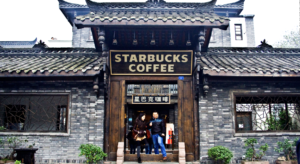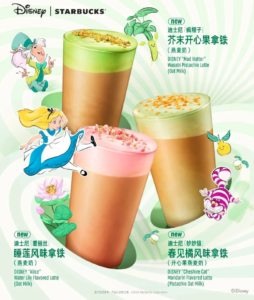From Seattle to Shanghai: Starbucks’ Brewing Coffee Success in the Chinese Market Through Culture, Development and Adjustments
Economically Speaking: East Asia’s Rising Influence
In recent years, the economic center of the globe has progressively shifted toward East Asia. In 2023, this region, which encompasses economic powerhouses such as South Korea, Japan, and China, accounted for more than 30% of the global GDP. In 2024, Gross Domestic Product (GDP) increased by 5.3% in the first three months of 2024 in comparison to the same period in the previous year, reported by BCC, solidifying its status as the world’s second-largest economy. Cities such as Tokyo, Seoul, and Shanghai are cultural and financial centers that infuse modern innovation with traditional heritage. Samsung and LG, tech titans from South Korea, dominate global markets, while the region is a leader in sectors such as electronics, automotive, and telecommunications. The record 1.5 million patent applications in 2022 serve as a testament to China’s leadership in renewable energy technologies and artificial intelligence. East Asia is a center for innovation and investment due to the region’s highly educated workforce and robust infrastructure, which attract multinational companies. Singapore, which is referred to as the “Gateway to Asia,” is a prominent location for global enterprises and expatriates due to its stable political environment, low taxes, and world-class connectivity.
While East Asia’s economic panorama continues to pique international interest, Western corporations must navigate distinct difficulties and opportunities when entering these regions. Adapting to local cultural norms and business practices is critical to success. A significant example of such adaptation is how American corporations, which have generally been linked with Western consumer habits, have altered their strategies to appeal to East Asian markets.
Starbucks Case: American Company Moves to China
The local population, who had traditionally preferred tea, was relatively unfamiliar with the concept of coffee culture when Starbucks first entered the Chinese market in 1999, as the Starbucks CEO noted in this podcast. Starbucks’ initial obstacle was to introduce and popularize coffee in a market where it was not a prevalent beverage option. Starbucks implemented a strategic strategy that encompassed education and localization in order to resolve this issue.
Stage 1: Strategies and Early Challenges
Starbucks encountered an initial obstacle in conforming its products to the preferences and flavors of its local customers. In order to increase the allure of coffee, they introduced beverages that were milder and sweeter, which were more in line with the tastes of the Chinese. Furthermore, Starbucks stores were intended to offer a comfortable and sophisticated atmosphere, which attracted young professionals and students seeking a contemporary and fashionable place to work and socialize.
Stage 2: Development and Expansion
Starbucks has effectively cultivated a coffee culture in China over the years. Starbucks has introduced numerous localized products that combine traditional festivals with consumer flavor preferences in order to accommodate the Chinese market. For example, Starbucks introduced the “ice zongzi” during the Dragon Boat Festival, which combines traditional rice dumplings with contemporary frozen treats, thereby appealing to youthful consumers. Starbucks annually distributes limited edition mooncake gift boxes for the Mid-Autumn Festival, which include traditional flavors as well as Starbucks’ signature coffee and tea flavors. Starbucks debuts red-themed beverages and gifts, including red bean lattes and specialty teas, as well as cups and gift certificates with zodiac designs, to commemorate the festive season during the Chinese New Year. Starbucks provides specially designed couples’ sets and themed beverages during the Qixi Festival, which is China’s Valentine’s Day. Furthermore, Starbucks has introduced products such as the Green Tea Frappuccino and Red Bean Frappuccino, which are popular summer choices due to their combination of traditional ingredients and modern beverages. These localized products have not only increased Starbucks’ appeal in the Chinese market but also established a more profound emotional connection with Chinese culture and consumer requirements.
Stage 3: Present Market Situation
Starbucks has integrated mobile ordering and payment solutions, making it convenient for tech-savvy Chinese consumers, by leveraging digital innovations and establishing strategic partnerships with local technology giants like Alibaba. This digital push has had a substantial impact on consumer engagement and loyalty, as evidenced by the millions of active users on their digital platforms.
Currently, Starbucks is a prominent coffee brand in China, and the company has ambitious plans to establish 9,000 stores by 2025. This will be achieved by opening a new store every 15 hours over the next five years. The company’s investment in local production and logistics, which includes a $220 million coffee production and logistics facility near Shanghai, emphasizes its long-term dedication to the Chinese market.
Western businesses are willing to adapt to its diverse cultural and commercial environments. Following its strategic adjustments in China, with sales rising by 18% in the second quarter of 2019, shortly after implementing localized menu items and digital enhancements. By customizing products to reflect local preferences and embracing digital platforms, Starbucks has not only expanded its footprint but also established a robust local presence that resonates with the cultural values and preferences of Chinese consumers. Looking ahead, Starbucks’ plans to expand its store count to 9,000 by 2025 illustrate an aggressive growth strategy that leverages these dynamics. This proactive approach will not only help Starbucks stay ahead in a competitive market but also set a benchmark for international companies aspiring to flourish in East Asia.





